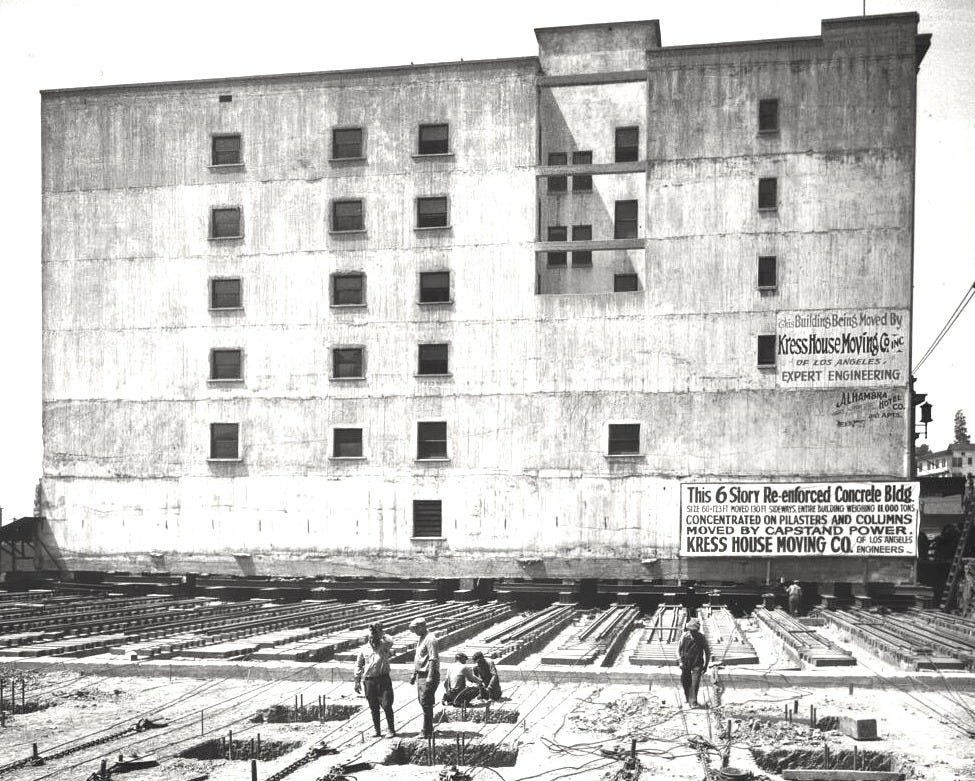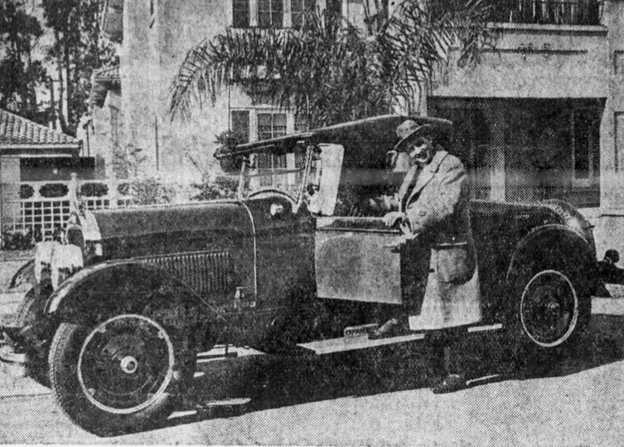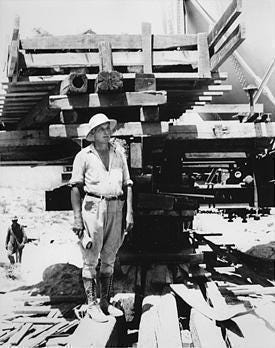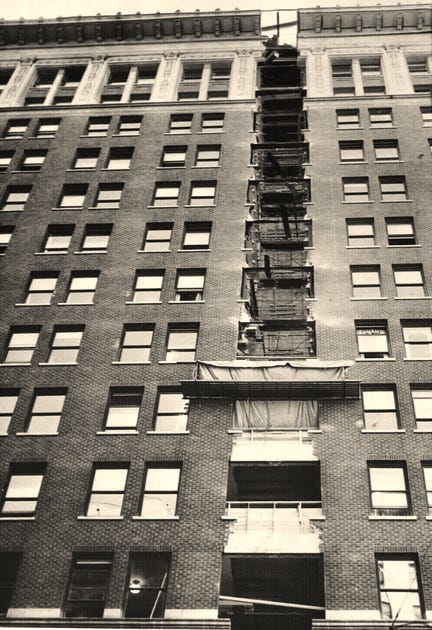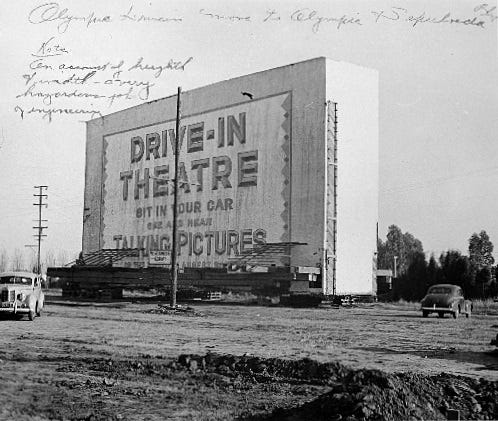Moving old buildings to new locations is big business in Los Angeles in the 1920s. Kress House Moving Company earns a reputation for relocating hard-to-move structures.
House moving is generally not financially feasible today. The 1920s are the heyday of structure relocation in Los Angeles. The economics of real estate and construction make it feasible to move even very large houses to new locations miles away from their original sites. The availability of vacant land and the absence of obstructions such as heavy traffic and the engineered environment add to the attraction.
Major street widenings in the 1920s also contribute to the demand. The city's streets have been laid out in the 19th century. As cars and trucks replace horses and buggies early in the 20th century, cities begin widening streets.
The process of structure relocation begins with excavating underneath. The structure is severed from the foundation. The whole structure, supported on a temporary wood or steel framework, is lifted off the foundation by manually turned screw jacks. Once the structure is at a sufficient height, the buildings are moved along steel rails on small steel rollers. Work animals (oxen or horses) pull the structure along the rollers. In later years, mechanical engines are used to power the move. After the move, the structure is lowered onto new foundations.
For a historic film click here: Haugh Hotel, Indianapolis in 1926 Kress-Oravetz House Moving Company (Pittsburgh).
The Kress House Moving Company (Los Angeles) is headed by George R. Kress,1 a self-educated contractor from Pittsburgh who has no formal training or college degree. He learns the business at his brother's2 Pittsburgh house-moving company. George Kress comes to Los Angeles in 1913 and acquires the D.R. Tripp house moving company - renaming it the Kress House Moving Company.
Kress, the king of Los Angeles’ house-movers, moved buildings - small and large. In 1924 Kress moves more than 250 buildings, and in 1925, moves its first 2-story brick building. Kress moves several Ocean Park brick buildings3 to allow the widening of Main St in 1926.
George Kress is never shy when it comes to new challenges. Kress House Moving Company - sample commercial structure relocations:
1923 Alhambra Hotel4 (Los Angeles)
1925 Compton High School5 (Compton)
1925 Motion Picture Studio6 (Hollywood)
1929 Stanton Building7 (Pasadena)
1931 Brunswig Drug Co. Building8 (Los Angeles)
1931 WCTU Building9 (Los Angeles)
1935 Commercial Exchange Building10 (Los Angeles)
1944 Drive-in Outdoor Screen11 (West Los Angeles)
After the Depression, the economics of structure relocation changes. People aren't as willing to undertake expensive projects. Unionization makes labor more expensive. The increase in traffic, and the engineered environment (street medians, overhead power lines, building density, etc) make it more difficult to move buildings along the streets. New city laws add a layer of bureaucracy, and there are fewer vacant lots on which to put the buildings.
George Richard Kress, Jr (1883 – 1972). Born in Pittsburgh PA. After his father, George Richard Kress, Sr (1848 – 1918), remarries in 1897, George lives with his older brother, Alfred. After 4 years of high school, from 1900 to 1910 George is listed as a plumber in Pittsburgh. In 1905 he marries Elizabeth Geneva Morris (1884 – 1930). In 1913 Kress comes to Los Angeles. From 1913 to 1940, Kress and his company move thousands of houses and commercial buildings.
In 1924 Kress and Geneva divorce (desertion). George marries Mabel M. Johns, but in an odd divorce case (House Mover Too Playful - Los Angeles Times, Dec 09, 1928) they divorce in 1928. In 1930, he marries Wanda Ninette Cooper Taylor (1893 – 1972). Their daughter, Wanda Dianne Kress (1936 - 1998), is born in 1935. In 1931, Kress builds a house for himself near the top of Benedict Canyon. The George R. Kress House is listed on the National Register of Historic Places. In 1940, Kress loses the house in a bank foreclosure. As the Depression deepens, people who owe him money become slow to pay.
Alfred S. Kress (1879 – 1980). Alfred, the eldest son, is born in Pittsburgh PA. He is the president of the Kress House Moving Company (Pittsburgh), whose motto is "If we had room to work, we could move the world." In 1904, with partner John A. Hanlon, the Kress-Hanlon Company moves a brick building for the H.J. Heinz Company. In 1926, with partner Michael Oravetz, the Kress-Oravetz House Moving Company moves the Haugh Hotel in Indianapolis. In 1927 in Pittsburgh, they move the Allegheny County Morgue. After Oravetz dies in 1946, Alfred Kress retires to Los Angeles.
Ocean Park. The following brick buildings are moved to allow the widening of Main St
J.S. Hunter Building 1-story 2702 Main St moved back 40 ft
J.H. Mathews Building 1-story 2812 Main St moved back 40 ft
California Apartments 2-story 2820 Main St moved to 2804 Main St.
Craigs Market 2-story 2924 Main St moved back 40 ft
Alhambra Hotel. For the County of Los Angeles, the 6-story concrete Alhambra Hotel is moved 122 ft north up Broadway to make room for the new Hall of Justice.
Stanton Building. To allow the widening of Colorado in Pasadena, a 10 ft wide slice is removed from the 3-story brick and stone Stanton Building. The foundations are severed and the front of the building is moved back on steel rails. This is faster and more economical than cutting off the end as it avoids the cost of constructing a new front.
Brunswig Drug Company Building. To allow the extension of Spring St, the building is acquired by Los Angeles County in condemnation proceedings. Using 1,200 jacks, 2000 steel rollers, 6 horses, and 150 workmen, the 10,000-ton 5-story steel and concrete building is rotated 90 degrees and moved 20 ft. The building is moved at 5 ft per hour by wire cables attached to 2 motor trucks. The cost to move ($68,000) and renovate ($10,000) is half the estimated cost to demolish ($35,000) and rebuild ($115,000).
Commercial Exchange Building. To allow the widening of Olive St, 5 ft needs to be removed from the 13-story Commercial Exchange Building. Rather than removing and rebuilding the building end, a middle section of the building is removed. With a 20-man crew, Kress cut out a middle section. In 9 hours, with a crew of 75 people, the west-facing half of the building is moved back and rejoined with its other half.
Outdoor Movie Screen. The massive outdoor screen at the southwest corner of Pico and Westwood boulevards is lifted up and transported 1.7 miles west to the northwest corner of Olympic and Bundy. The drive-in theatre opens on Pico in 1934 with a single huge speaker on top of the screen— much to the neighbors’ annoyance.



